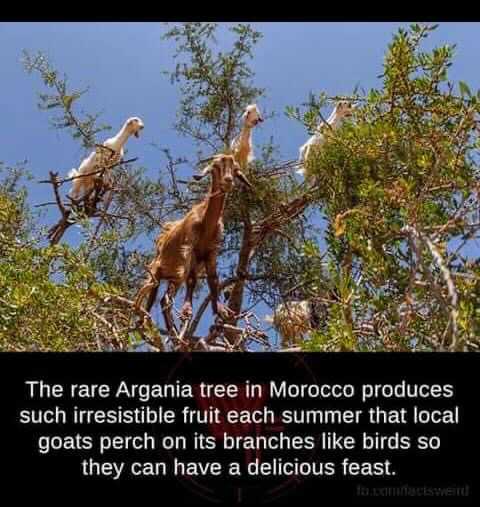If you are wondering if those are actually goats perched on branches in the meme below, then you’re not wrong. Those are real goats balancing on the branches of an argan tree.
An argan tree, according to National Geographic, largely grows in Morocco and western Algeria. It produces a fruit that ripens in June and looks like a shriveled olive. The trees have gnarled and thorny branches and are also famously known for their production of argan oil, one of the most highly sought after luxury items in the world.
But goats love them for their fruit, and will climb many feet to get to them. A CBS News story shows the goats climbing onto the tree:
The tree’s fruit has an indigestible nut at the center, which contains seeds used to make valuable argan oil. After consuming the fruit, the goats actually excrete or spit out the nut, which is then collected by hand. According to CBS News, the goat’s digestive tract makes it easier to crack the nut open. The video above shows the full process.
However, climate change and over-harvesting have been posing challenges to the growth of baby argan trees. Furthermore, the goats may not be helping even though they are dispersing the tree’s seeds in the process, according to a study titled “Tree-climbing goats disperse seeds during rumination.” Co-author, biologist and ecologist Jose Fedriani told NPR:
If we have a huge number of goats, they eat all the new baby trees, they kill them, so even though the goats are dispersing the seeds, they are eating the baby trees. So the effect is negative. But if there is a small or moderate number of goats, they will not kill all the baby trees produced by the dispersed seeds.
[…]
These people who take care of the argan trees get money from selling the argan fruit, so they buy more goats. So there is no rejuvenation of the argan forest because the goats are eating all the baby trees.
Ultimately, Fedriani argued, “We need to have a balance between the number of goats and number of trees and try to keep the equilibrium.”
Are These Real Tree-Climbing Goats in Morocco?
Source: Kapit Pinas

0 Comments